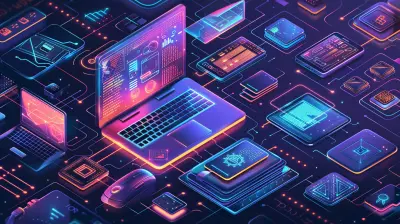13 March 2025
In today's digital age, education is transforming at breakneck speed. With new technologies emerging every day, it's no wonder that traditional teaching methods are getting a fresh facelift. Among the headliners of this transformation? Open-source software. You’ve probably heard the term thrown around in tech circles, but did you know it's making waves in the classroom too? Yup, open-source tools are like the unsung heroes quietly revolutionizing the way teachers teach and students learn.
But wait, what exactly is open-source? And why should educators care? Let’s break it down.

What is Open Source?
At its core, open-source software is software whose source code is freely available for anyone to view, modify, and distribute. Think of it like a recipe. Instead of keeping the ingredients and instructions locked away in grandma’s secret drawer, you share it with the world. Anyone can tweak the recipe to their liking, improve it, or pass it on to others. Pretty cool, right?Now, compare that to proprietary software, which is more like a pre-packaged meal. You can use it, but you don’t get to see how it’s made or alter the ingredients.
In education, open-source software provides educators and students with powerful tools without the hefty price tags associated with traditional software. Let’s dive into how these tools are reshaping the classroom and why they're worth considering.

Why Open Source Matters for Education
1. Accessibility for All
One of the biggest advantages of open-source software is that it's free. This makes it incredibly accessible, especially for schools or students operating on tight budgets. Not every institution has the funds to splurge on expensive licenses for proprietary software, and not every student can afford costly tools. With open-source solutions, schools can provide high-quality educational tools without breaking the bank.For instance, a school in a low-income area that can’t afford proprietary tools like Microsoft Office can instead turn to LibreOffice, which offers similar word processing, spreadsheet, and presentation software—completely free of charge.
2. Customization and Flexibility
Open-source isn’t one-size-fits-all—it's more like a tailor-made suit. Because the source code is accessible, educators and students can tweak the software to better fit their needs. Imagine being able to change how a tool functions just so it works better for your classroom environment. That’s the power of open-source.For example, a district's IT department could customize a learning management system (LMS) like Moodle to align with the school’s specific curriculum or grade-reporting needs. Proprietary software often doesn’t offer this level of flexibility, leaving you stuck with what you’ve got.
3. Encouraging Digital Literacy
When students use open-source tools, they’re not just learning how to use software—they’re learning how that software works. With the source code available, students can peek under the hood, so to speak. This can be an invaluable learning experience, particularly for those interested in coding, software development, or engineering.By working with open-source software, students can experiment, make mistakes, and learn by doing. It’s like giving them a car, not just to drive but to take apart and rebuild. This hands-on experience fosters a deeper understanding of technology and can set them up for success in the tech-driven world of tomorrow.
The Best Open-Source Tools for Teachers and Students
So, what are some of the best open-source tools available for teachers and students? Whether you're an educator looking to enhance your classroom or a student hunting for ways to improve your learning experience, these tools have got you covered.1. Moodle
Moodle is one of the most popular open-source Learning Management Systems (LMS) around. If you’ve ever taken an online course, there’s a good chance it was hosted on Moodle. What makes it so attractive is its flexibility. Teachers can create courses, quizzes, forums, and even track student progress—all within Moodle. And because it’s open-source, schools can modify the platform to better suit their needs.What’s more, Moodle has an active community of users and developers who constantly contribute new plugins and features, making it even more versatile. Whether you're running a full-fledged online course or just a classroom discussion board, Moodle has you covered.
2. LibreOffice
If you're tired of shelling out for Microsoft Office, then LibreOffice is your new best friend. It’s a full-featured office suite that includes a word processor, spreadsheet program, presentation maker, and more—all for the low price of absolutely nothing.LibreOffice is widely praised for being almost identical to Microsoft Office in terms of functionality. Whether you're writing an essay, creating a presentation, or crunching numbers in a spreadsheet, LibreOffice has all the tools you need. Plus, it supports Microsoft file formats, so you don’t have to worry about compatibility.
3. GIMP
If you’ve ever dabbled in graphic design, you know that Adobe Photoshop is the industry standard. But it comes with a hefty price tag. Enter GIMP (GNU Image Manipulation Program), the open-source alternative.GIMP is a powerful image editing tool that allows students and teachers to create stunning visuals for presentations, websites, or even just for fun. It’s not quite as feature-packed as Photoshop, but for most educational purposes, it’s more than enough—and did we mention it’s free?
4. Tux Paint
For younger students or budding artists, Tux Paint is a fun and easy way to introduce them to digital art. It’s a simple drawing program designed specifically for kids, with a range of tools that encourage creativity. Think of it like Microsoft Paint, but with way more options and a kid-friendly interface. Teachers can use Tux Paint for a variety of classroom activities, from art projects to creating simple infographics.5. OpenShot
Video editing is becoming more and more important in the classroom, whether it’s for student projects or teacher-created instructional videos. But decent video editing software can be pricey. OpenShot is an open-source, user-friendly video editor that packs a punch. It allows students and teachers to create professional-looking videos without any prior experience.With features like drag-and-drop functionality, keyframe animations, and unlimited tracks, OpenShot makes video editing accessible to everyone. And yes, it’s free!
6. Scratch
Have you ever wanted to introduce coding to your students but didn’t know where to start? Scratch is an open-source programming language specifically designed to help kids learn the basics of coding in a fun, engaging way.Using a visual interface, students can create their own interactive stories, games, and animations. It’s like Lego for coding—the building blocks are there; all the students have to do is piece them together to make something awesome.
7. H5P
If you’re looking to add some interactivity to your lessons, H5P is a fantastic open-source tool that allows teachers to create interactive videos, quizzes, and presentations. It integrates with popular platforms like Moodle and WordPress, making it easy to embed interactive content directly into your courses.What’s great about H5P is that it promotes active learning. Instead of passively watching a video or reading a document, students can engage directly with the content, making the learning process more engaging and dynamic.
How to Get Started with Open Source in Education
So, you’re sold on the idea of open-source tools, but how do you actually integrate them into your classroom? Here’s a quick step-by-step guide to get you started.1. Assess Your Needs
Start by identifying what you or your students need. Do you need a tool for creating presentations? A way to track student progress? Or maybe a platform for interactive quizzes? Once you’ve got a clear idea of the tools you require, you can start hunting for open-source alternatives.2. Do Your Research
There’s a wealth of open-source tools out there, so take the time to do some digging. Look for reviews, community feedback, and tutorials to find the best fit for your needs. Sites like GitHub and SourceForge are great places to browse popular open-source projects.3. Start Small
If you’re new to open-source software, it’s best to start small. Pick one or two tools to test out before diving in headfirst. This way, you can get a feel for how open-source works without overwhelming yourself or your students.4. Join Communities
One of the best parts about open-source software is the community that comes with it. Join forums, mailing lists, or social media groups related to the software you're using. These communities are often filled with helpful individuals who can answer your questions and offer tips for getting the most out of the software.5. Train Your Students
If you’re introducing open-source tools to your students, take the time to show them how to use the software effectively. Offer tutorials or create cheat sheets to help them get up to speed quickly.Conclusion
Open-source software is a game-changer for education. Whether you're a teacher looking to enhance your lessons or a student looking for powerful tools to help with your studies, open-source software offers a world of possibilities—without the financial burden of proprietary software. From office suites and LMSs to coding platforms and video editors, there’s an open-source tool for just about everything in education.So, why not give it a try? Who knows, you might just find the perfect tool to take your classroom or learning experience to the next level.











Zara McLain
Great article! Open source tools truly empower both teachers and students, fostering creativity and collaboration in the classroom. It's exciting to see how these resources can enhance learning experiences and make education more accessible. Can't wait to explore more about this topic!
April 8, 2025 at 3:19 AM